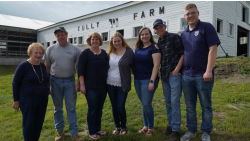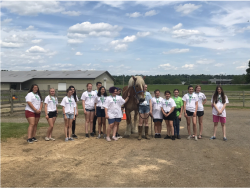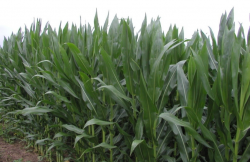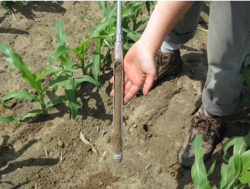Events
Announcements
PSNT Fact Sheet
Announcements:
2019 Massachusetts Outstanding Dairy Farm Award
The University of Massachusetts Crops, Dairy, Livestock, and Equine team would like to congratulate Tully Farm in Dunstable, MA for receiving the 2019 Outstanding Dairy Farm Award.
In 1872, Henry and Mary Tully purchased a farm on Hollis Street. In 1901, Charles E Tully, the son of Henry and Mary, purchased the Drake property, located further up on Hollis St. The Drake property consisted of 40 acres of land. The Tully family continued to add land and expand the farm over time. In 1919, Charles E. bought the Rideout Farm on Fletcher St. The farm consisted of 200 acres of land. In 1940, Charles and his son George purchased the Lawrence Farm, which is located in Pepperell, MA and Hollis, NH, adding another 120 acres to the farm. George, his son Charles W., and his brother Eugene formed Tully Farms Inc. in 1970. George's grandson Charles W. Jr. joined the corporation after high school and is currently the president. The Tully Farm has undergone many changes throughout the years, including new barns and technology, and the family plans to continue their dedication to quality farming for many years to come. Since 1872, the Tully Family has been milking cows in Dunstable MA. Almost 150 years later, they have continued to raise holstein cows to produce high quality, fresh milk. Six generations have worked (or are currently working) on the farm with help from many family and friends along the way.
Introducing “Stockbridge Sonnet UM” and “Bay State Ophelia”'
We are thrilled to announce the arrivals of our newest additions at the UMass Hadley Farm: a Hanoverian foal named "Stockbridge Sonnet UM" (lovingly nicknamed "Levi" as the barn name) and a Morgan horse, Bay State Ophelia!
Stockbridge Sonnet (pictured left) was born at 12:29am on June 11, 2019, out of Elite Hanoverian mare "Alessandra Q" (donated by Suzanne Quarles/Some Day Soon Farm) and by FEI Grand Prix dressage stallion "Schroeder" (owned by Kathy Hickerson/Majestic Gaits). The foaling crew included Rob Navaroli (Sustainable Food & Farming '19), Rebecca Lotane (Equine Mgt '16), Haleigh Tyerman (Ansci '22) and Vanessa Cote (Ansci '21). They chose the name to honor Levi Stockbridge, the first professor of agriculture at Massachusetts Agricultural College (now UMass), and also as a special salute to the closing AS Equine Management program. Bay State Ophelia (pictured right) was born June 14 at 3:42am out of dam U.C. Mischief Managed "Emma" (UC Domination x UC Courage Under Fire) and by stallion Gladheart Black Harris (DJJJ Ebony Gold x Rogue's Midnight Melody) owned by Jack & Nadette Stang in Oregon. Our new Bay State Ophelia is a tribute to UMass's long tradition of breeding Morgan horses. Ophelia (born 1944) was one of the original government Morgans that came to UMass from the US Morgan Horse Farm in VT when the government herd was dispersed in 1951. Ophelia was bred to prolific government stallion Panfield and foaled out "Bay State Victress" at UMass on July 19, 1951.
4-H Summer of Science at UMass Hadley Farm
Middle and High School students from across the state were engaged in hands-on learning at the UMass Hadley Farm as part of the 4-H Summer of Science Youth Development program. Each year young people have the opportunity to select a track of study where they spend the day exploring a field of science with faculty, staff or a professional in the field. Students interested in the Pre-Vet track had the opportunity to work with Dr. Cassandra Uricchio and Jillianne Smith from the Veterinary & Animal Science department learning about Equine Behavior & Learning Theory. The youth certainly enjoyed practicing operant conditioning with the UMass Horse Herd, especially the UMass police horse "Miller" (see photo below)!
Pre-Sidedress Nitrate-nitrogen Test (PSNT)
Masoud Hashemi (UMass), Rick Kersbergen (UMaine), Samantha Glaze-Corcoran (UMass), Alexa Smychkovich (UMass)
INTRODUCTION
All crops require a relatively large amount of nitrogen (N) to achieve optimum growth and yield. However, among all the essential nutrients required by plants, N is perhaps the trickiest nutrient; this is because N is 100% water soluble and can easily leach due to rainfall or with irrigation water. In addition, N can easily be lost to the environment through volatilization, evaporation, and denitrification. In areas with high rainfall potential in the spring, such as in the Northeast, the application of N fertilizer as pre-plant or at planting time often results in significant N loss that increases the cost of production. This N loss can also be a serious pollution threat to both underground and surface water, and it can contribute to greenhouse gas production. By contrast, applying sidedress N is a more efficient use of fertilizer and it is more environmentally friendly
Soil organic matter (SOM) contains the largest pool of soil N, which can comprise more than 90% of the total N in soil. SOM is continuously decomposed by soil microbes, which makes the N in the SOM available to plants via a process called mineralization. A rough estimate indicates that 2 to 4% of soil organic N will be mineralized each growing season. This is equivalent to approximately 20 to 40 lbs. of available N per acre for each 1% of organic matter in the top 6” of the soil. Any factor that affects microbial activity, such as soil temperature or moisture, can influence the rate of mineralization. Therefore, the decomposition of organic matter and the corresponding release of nutrients, N in particular, reaches its peak in the month of June and stays at peak through late summer, tapering off as the soil gradually gets cold again in the fall months. Soils that are high in organic matter have the potential to release a significant amount of N that may meet the N requirement of the crop or reduce the need for supplemental N fertilizer.
The pre-sidedress nitrate-N soil test (PSNT) is a late spring nitrogen test that was introduced by Professor Fred Magdoff (University of Vermont and others). The test is used to measure the soil’s capacity to provide plant available N during the growing season by mineralization. The higher the soil organic matter, the higher the potential that plant available N will meet the N requirements of the crop. The PSNT is usually performed in June or early July when the soil is warm enough for optimum microbial activity. This time point also correlates with when a developing corn crop will begin to grow exponentially and substantially increase N uptake accordingly.
Currently, the PSNT is used not only for corn. It is also utilized with other crops that accumulate N rapidly within a single growing season. Examples include tomatoes, peppers, lettuce, fall planted cabbage, butternut squash, and pumpkins. According to Dr. Vern Grubinger (University of Vermont), the threshold for these crops is slightly higher than corn because they do not have a deep and extensive root system like corn. Crops with shallower root systems require a higher level of N in their root zones to meet their N needs (please refer to New England Vegetable Guide for N need of various vegetables).
PSNT is an especially appropriate test for fields that are relatively high in organic matter and that are historically fertilized with manure. Over-application of N in the form of commercial fertilizer or manure can result in N loss during the growing season, especially after the crop is harvested in the fall. This fact sheet is mainly focused on corn fields with a history of manure application and cover cropping.
SAMPLING SOIL FOR PSNT
- Soil samples for PSNT should be taken about 10 days before the time of sidedressing. For corn, this is when the plants are about 10–12 inches tall (about 5-6 weeks after planting) from the ground surface to the center of the whorl.
- Sampling should not be done after recent heavy rains, as the resulting values may underestimate the potential of the soil to supply N.
- In row crops such as corn, the samples should be taken from the middle of the rows, far enough from banded fertilizer and at a depth of 12 inches.
- Since PSNT is based on microbial mineralization, the samples should be immediately air dried in a thin layer or kept in a fridge until the sample is sent to the lab. This is because microbes in the soil sample will otherwise continue to be active and will release plant available N. If this occurs, the test results may not be representative of actual field conditions.
- Some Extension offices and private crop advisers may offer “quick tests” to their growers to expedite sending results to growers.
- The amount of nitrate present at the sampling time is directly related to the capacity of the soil to supply N for the remainder of the growing season. Sidedress nitrogen recommendations are a guide, and N application sources and application methods will vary depending on the fertilizer source.
INTERPRETING THE PSNT REPORT:
- Depending on the PSNT level, a farmer receives an estimate of additional N fertilizer that will generate a crop yield response when applied as sidedress.
- Often, soil labs only report the concentration of nitrate in the soil. The recommended rate of N application as sidedress depends on the type of the crop, and in case of corn silage, also depends on the expected or historical yield potential from the field. Obviously, the higher the silage corn yield that is expected, the higher the rate of sidedress N fertilizer likely required to meet yield expectations.
- Research has shown that when the PSNT result indicates that there are ≥25 ppm nitrate in the soil, it is unlikely that additional N applied at sidedress will result in an economically advantageous yield increase in corn (silage, grain, and sweet). The threshold for vegetable crops is higher than corn and often is about 30 ppm.
- Mineralization of SOM is strongly influenced by environmental conditions. When weather conditions in the spring are cold, mineralization is slow, thus the capacity of the soil to release N is likely to be underestimated. In dry seasons, PSNT may overestimate the N contribution from the soil because movement of N to the active root zone is reduced. Therefore, the sidedress application rate should be adjusted based on the farmers’ experience and judgement. For example, if the soil has been cold in the spring and the PSNT results are about 20 ppm, chances are that the mineralization in the soil has not yet reached its peak value, thus no sidedress N should be applied.
- When PSNT values are less than the threshold (25 ppm in corn and 30 ppm in vegetable crops) growers usually apply additional N. While PSNT values below these critical levels may or may not respond to additional N fertilizer, the stock recommendation would be that the crops should receive more N. The following table presents the amount of recommended sidedress N fertilizer based on the PSNT values and the expected yield of corn silage.
- The PSNT test should also be used as an historical record to evaluate fields with regular or repeated manure applications as these fields typically have higher levels of SOM and greater N mineralization potential. Growers might consider altering manure practices on fields with consistently high PSNT values, especially as soil phosphorus values may also be increasing and potentially causing other environmental impacts.
| Soil Nitrate Level (ppm NO3-N) | Expected Corn Silage Yield (tons/acre) | |||
| 17 - 20 | 21 - 24 | 25 - 29 | ≥30 | |
| Sidedress N recommendation rate (lbs. N/acre) | ||||
| < 10 | 100 | 120 | 150 | 170 |
| 10 - 15 | 75 | 90 | 120 | 140 |
| 16 - 20 | 50 | 70 | 90 | 110 |
| 21 - 25 | 30 | 50 | 70 | 90 |
| > 25 | 0 | 0 | 0 | 0 |




